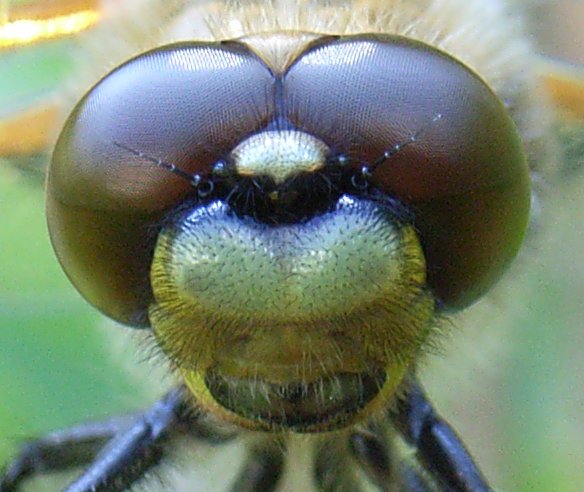Facts
Up-close photo of a four-spotted chaser's eyes. Public domain image taken from commons.wikimedia.org.
Some additional facts about
Libellula quadrimaculata:
This species is unique from others in the Family Libellulidae in a
few aspects. Firstly, many of the dragonflies in this family are
easily distinguishable between male and female by a glance. Male and
female four-spotted chasers, however, are both extremely similar in
physical appearance. One of the only physical differences is that
males sometimes have a blue color along the underside of their
abdomen. An additional difference between them and others in the
Family Libellulidae include the fact that their abdomens are thicker
and larger than others'. This is another distinguishing feature of
the species (Schindler, et. all, 2003).
Dragonflies have the best eyes out of all other insect species. Each eye has about 30,000 lenses, and the dragonfly can see all the way around the entirety of the eye, giving them a wider range of vision than humans (Willigalla & Fartmann, 2012).
Libellula quadrimaculata is the state insect of Alaska. It was given this designation in 1995. On this choice of insect, State Representative Irene Nicholia is quoted in saying that "the dragonfly's ability to hover and fly forward and backward reminds us of the skillful maneuvering of the bush pilots in Alaska (StateSymbolUSA.org)."
We chose to research the four-spotted chaser because we thought dragonflies would be interesting to learn more about - and they are! A dragonfly's wings only beat about 30 times per second. That may seem like a lot, but compare that to the average fly, who beats its wings around 200 beats per second, or a bee, who clocks in around 350! The dragonfly's two sets of larger wings make it possible for them to work less hard when flying at the same, if not faster, speeds as other insects.
Go back to Interactions
Go back to Home
Continue onto References
